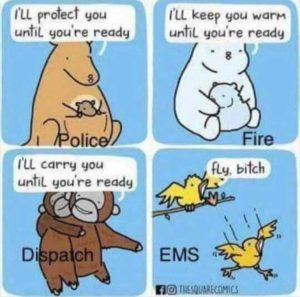Well, I’ve been away from my blog for a while. There are two reasons. First, I’ve been busy. Those of you who know me know that I’ve changed one of my volunteer affiliations. (More on that later.) Two, I tend to blog when the muses inspire me. And this afternoon, the inspiration finally hit me.
So, let’s talk about that volunteer position. Obviously, in keeping with discretion and good sense, I won’t say which department. But what I will say is that they’ve been unlike almost any fire department I’ve seen. It’s a combination paid/volunteer department that actually welcomes volunteer involvement. It’s easy to get on the schedule and, by and large, you’ve got the equipment and uniforms to do your job. They embrace the EMS first response role — to the point of having paramedic level protocols and an active volunteer role for those who want to stay exclusively on the medical side of the department.
Truth is, I’ve probably been one of the bigger critics of the fire service both in terms of its commitment to quality medicine and its love/hate relationship with volunteers. And I realize that I might’ve found that rare unicorn that’s rumored to exist.
And in EMS, many of us respect certain aspects of the fire service, particularly the perceptions of brotherhood and camaraderie. And we rightfully blame many EMS organizations for a toxic management culture that doesn’t respect clinical competence, that values the bottom line above all else, and where “meets minimum standards” is the gold standard. We also blame an EMS social media culture that appeals to the lowest common denominator of inappropriate humor mocking patients, where patient abuse is funny, and where “book learning” is for the other guy because you “do everything a doctor does at 70 miles an hour.”
And truth be told, I’ve despaired of this culture in EMS as well. Even though I should know that toxic cultures exist throughout the human experience (and I’ve worked in some toxic legal settings), I let the EMS social media world convince me that this is an EMS problem, not a human or management problem.
Until today. I just happened to see a post from a firefighter I used to know. His post was full of braggadocio about “leading and training.” The fire service seems to be full of these guys. They’re the fire service version of the lowest common denominator medics on EMS social media. And the truth is that a lot of the firefighters who talk a big game on social media like they’ve got the experience of firefighters in urban departments like Houston, New York City, Chicago, Providence, or Boston are the fire service version of the EMS social media clowns who are career EMTs doing interfacility transfers and dialysis runs. And just like in EMS, there are plenty of lousy managers the fire service and perhaps even more so-called leaders whose only expertise is in self-promotion.
So, what’s the point here? Namely, it’s not just EMS — every profession and human endeavor has its share of buffoons hogging the attention as well as toxic folks creating an even more toxic culture. If you’re in an organization where you’re valued and the toxicity is minimal, treasure it and do what you can to keep that culture going. If you’re in the other kind of organization, do what you can to improve things. If all else fails, do yourself, your career, and your mental health a service and find a better option.
For what it’s worth, the good options in any career, and especially in emergency services, are out there. You have to look for them.
One final note — the really great organizations rarely have to advertise or promote themselves. They attract quality and the right people without a hashtag or cute slogan.
